Well, we’ve had a good run but our time with Google Optimize is coming to an end. By now you’ve probably heard that Google Optimize will sunset on September 30, 2023 and may be looking for a new experimentation tool.
If you’re considering migrating from Google Optimize to Optimizely, there are several key differences to understand. While both tools allow you to set up A/B tests to optimize your website, there are some distinct features and capabilities. In this article, we’ll explore key things to consider, and provide tips for making the switch as seamless and successful as possible.
The Initial Implementation Process Could Be Substantial
Since Google Optimize is tightly integrated with Google Analytics, usually there was minimal implementation required to get up and running with launching tests. However, you can expect this to be a bit more involved when getting started with Optimizely.
Just like Google Optimize, Optimizely requires the implementation of a simple JavaScript snippet in the source code of each site. Optimizely recommends placing the snippet as close to the top of the <head> tag on each page as possible. Nothing really so different there.
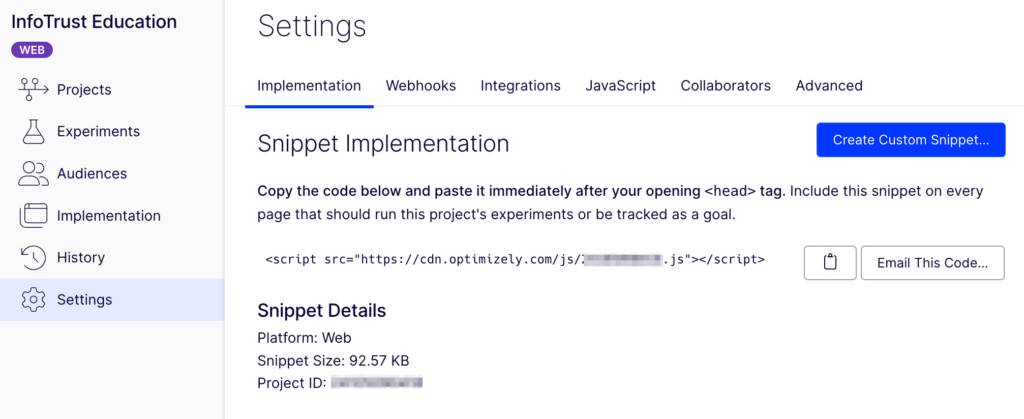
However, Optimizely also recommends doing as much of the in-platform setup as possible before launching any tests. Typically this involves defining most of your pages, events, and audiences at the beginning of your configuration process.
In Optimizely, pages are reusable templates that define where and when experiments are delivered. These are primarily configured via the application of URL pattern-based rules in the platform. You should plan to set these up for key pages that represent a variety of templates throughout your site—for example your homepage, checkout pages, application pages, etc. You also have the option to add more advanced conditions such as listening for the presence of a specified element or a custom JavaScript condition. Setting up the pages in advance will help you save time by reusing this configuration on multiple experiments in the future.
One of the most important parts of your Optimizely implementation is setting up events which allow you to track specific user interactions or conversions on your website. You can create three types of events in Optimizely: click, custom, or pageview.
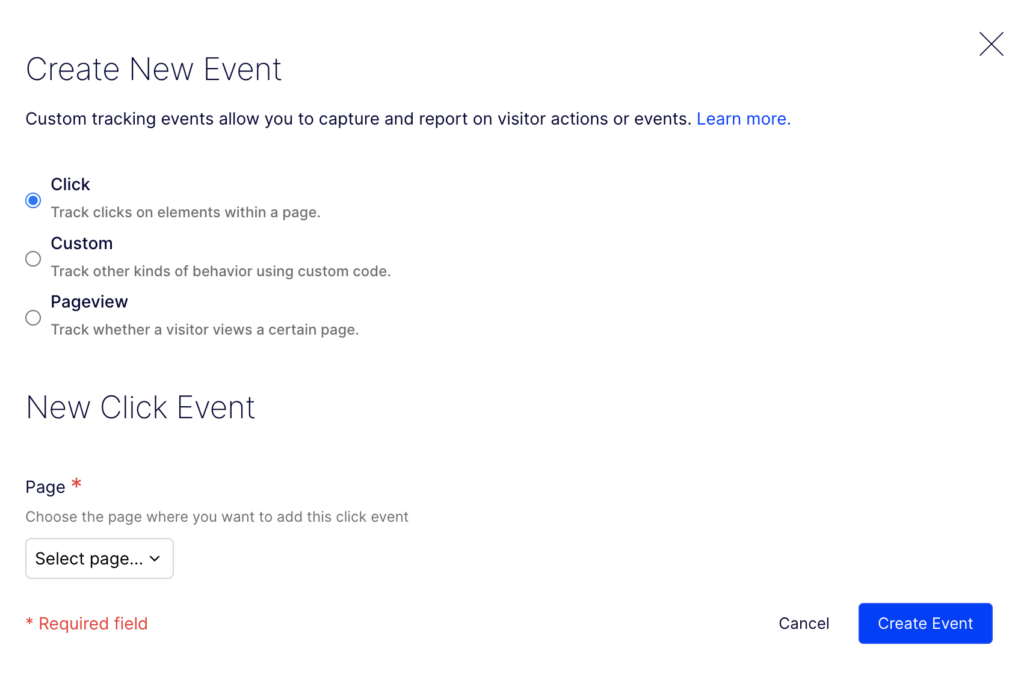
Click events capture user clicks on specific elements that you define like buttons or menus. The Optimizely interface allows you to easily view the relevant page and select the CSS selector for the element interactions you want to record in your experiment.
Pageview events automatically capture visits to the pages you configure in the Optimizely platform. You might choose this option to record how the changes you make in an experiment influence how often a user visits a confirmation page or any product page.
Custom events allow you to record specific information about user activity that may not be covered by a simple click or pageview event. Examples of custom events could include e-commerce transactions, form completions, or completion of multi-step applications. If you have used Google Optimize in the past, this will require some new implementation either in your source code or your tag management system to send a custom script to Optimizely every time the event occurs.
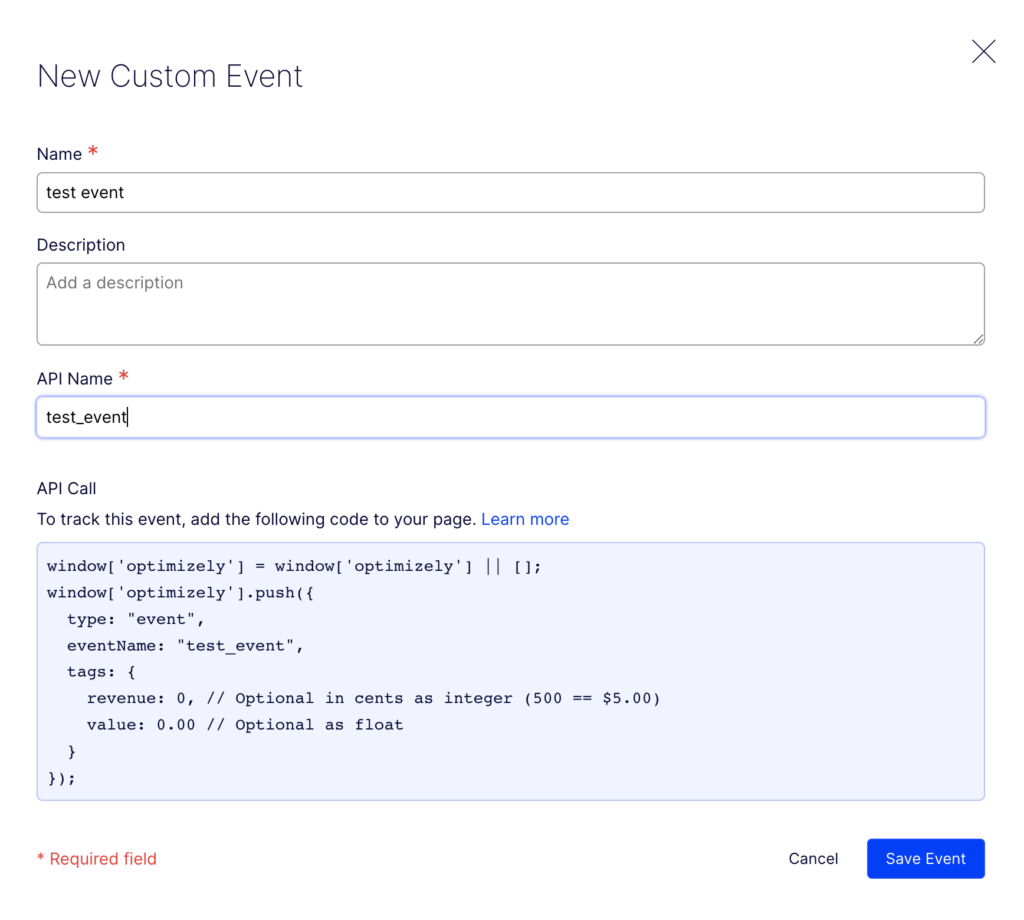
In Optimizely, audiences refer to specific groups or segments of your website visitors or users who you can target for experiments or personalization. These audiences are used to define which subset of your overall traffic will be exposed to a particular variation of your web content or user experience during an experiment. Configuring audiences in Optimizely involves specifying the criteria or conditions that determine which visitors fall into a particular audience segment. Audiences should also be configured in advance whenever possible.
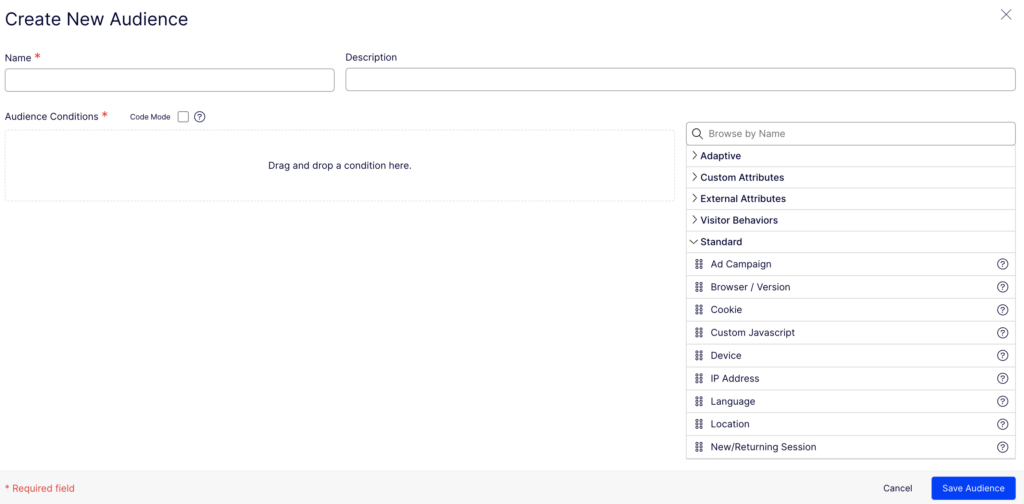
Similar to the process of implementing an analytics strategy, we highly recommend creating a document that lists and defines all of your pages, events, and audiences, as well as any implementation requirements. Taking the time to document and set up your key measures of success in Optimizely will help ensure your experimentation program runs efficiently.
There Is No Anti-Flicker Snippet for Optimizely
If you have been a Google Optimize user in the past, you may wonder if you need or have the option to add an additional snippet that prevents page flickering. Well, that is not a thing in Optimizely. But, it is highly recommended that you install the Optimizely snippet directly in your source code rather than in your tag management system to have the greatest chance of a low flicker experience.
Don’t Forget the Optimizely Assistant Chrome Extension
Optimizely Assistant is a suite of tools that allow you to QA and debug your experiments directly in the browser.

This extension prints key details to the console log screen such as confirmation of the presence of an experimentation snippet, active campaigns and experiments, variants you are currently exposed to, and the experimentation pages that are currently active. You can also use it to view and validate events as they fire to make sure they are properly collected by Optimizely.
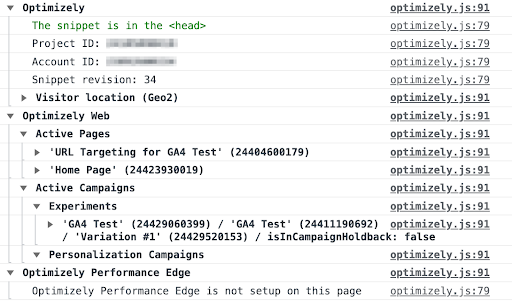
You can find the Optimizely Assistant extension in the Chrome Web Store. Plan to use this tool as part of your quality assurance processes before and while running tests.
Redirect Experiments Are a Bit Hidden
You won’t see a redirect test listed as one of the default options when creating a new experiment in Optimizely.

But that doesn’t mean it isn’t an option. To create a redirect test—where you redirect users to a new page altogether instead of making changes to an existing page—start by selecting the A/B Test option. Once you open the variation editor, you can choose to create a change where you will have the option to redirect a page to a different URL.
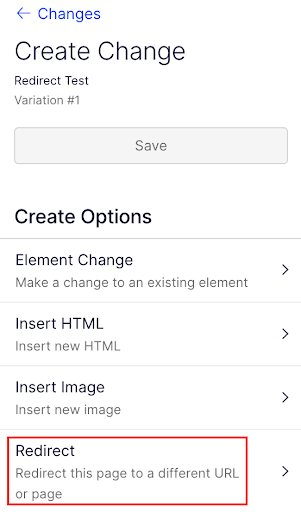
Terminology Differences between Google Optimize and Optimizely
When it comes to A/B testing tools, it’s important to understand the terminology used by each platform. While Google Optimize and Optimizely share many similarities, there are some differences in the terms they use.
For example, Google Optimize refers to different versions of a page or element as “variations.” On the other hand, Optimizely uses the term “experiences” to refer to the same thing. While this may seem like a small difference, it’s important to keep in mind when communicating with the platform’s support team or analyzing your experiment results.
Another terminology difference between the two platforms is the way they refer to the goals you set for your experiments. Google Optimize calls them “objectives,” while Optimizely uses the term “metrics.” It’s important to understand these differences in order to effectively set and track your experiment goals.
By taking the time to learn the terminology used by your A/B testing platform, you can avoid confusion and ensure clear communication across teams during your implementation and onboarding of Optimizely. Additionally, understanding the terminology can help you better analyze and interpret your experiment results, leading to more effective optimization of your website or app. Here is a chart for quick reference.
| Optimize Term | Optimize Definition | Optimizely Term | Optimizely Definition |
|---|---|---|---|
| Container | Holds all of the configurations for experiences on a particular site | Project | A way of managing experiments within a single application or site |
| Objectives | The website functionality you want to optimize | Metric | A quantitative measure of a visitor's action |
| Editor Page | The web page used as the template to create site changes, which apply to every page that matches the URL targeting rules | Editor URL | The URL that you want to load in the Optimizely Visual Editor as a basis for changes |
| Experience | Including A/B test, multivariate test, redirect test, and personalization | Experiment | A/B testing, multivariate testing, and multi-page (funnel) testing |
Optimizely Offers Multi-Armed Bandits
A multi-armed bandit test in Optimizely is a type of experimentation methodology used for website optimization and A/B testing. It is an alternative to traditional A/B testing where you compare a control (the original version) with one or more variations of a page to determine which performs best based on a predefined metric, such as conversion rate or click-through rate.
The term “multi-armed bandit” is derived from the analogy of a gambler facing a row of slot machines (bandits), each with its own lever (arm) to pull. In a multi-armed bandit test, the goal is to find the best-performing variation as quickly as possible while still maximizing overall gains. It achieves this by dynamically allocating more traffic to variations that show promise and less traffic to those that are underperforming.
At the start of the test, traffic is evenly distributed among all variations, including the control. As the test progresses, Optimizely continuously monitors the performance of each variation. It uses statistical algorithms to estimate the conversion rates or other relevant metrics for each variation. Optimizely dynamically adjusts the traffic allocation to favor variations that appear to be performing better. Variations with higher estimated conversion rates will receive more traffic, while underperforming variations receive less.
The benefits of a multi-armed bandit test in Optimizely include:
- Faster discovery of the best-performing variation
- Improved efficiency as traffic is allocated where it’s most likely to have an impact
- Ability to adapt to changing user behavior or external factors in real time
- Reduced risk of “locking in” traffic to a poor-performing variation
This may be a completely new concept to you if you’ve been using Google Optimize so keep in mind that multi-armed bandit tests may not be suitable for all situations. They are most effective when you have a high-traffic website and need to make quick optimization decisions. Traditional A/B tests might still be preferable when you have specific hypotheses to test or when you want to ensure full control over traffic allocation during the experiment.
Summary
Optimizely is a powerful tool that can help you optimize your website, increase conversions, and improve user experience. However, if you’re new to the platform, it can be overwhelming to know where to start. Fortunately, Optimizely offers a variety of support resources, including partners like InfoTrust to help you get started and make the most of the platform.
One of the best ways to get started with Optimizely is to take advantage of their onboarding and training resources. These resources are designed to help you learn the basics of the platform and start using it effectively. Optimizely offers a series of webinars, tutorials, and guides that cover everything from setting up your first experiment to advanced testing strategies.
Optimizely offers robust reporting capabilities, but the terminology and metrics used may be different from what you’re used to in Google Optimize. Be sure to familiarize yourself with Optimizely’s reporting features and metrics so you can accurately track and measure the success of your experiments.
Migrating from Google Optimize to Optimizely is a smart move if you’re looking to future-proof your website optimization strategy. By understanding the key differences between the two platforms, taking advantage of Optimizely’s support resources, understanding reporting, integrating with other platforms, and familiarizing yourself with Optimizely’s unique terminology, you can ensure a smooth and successful transition.


